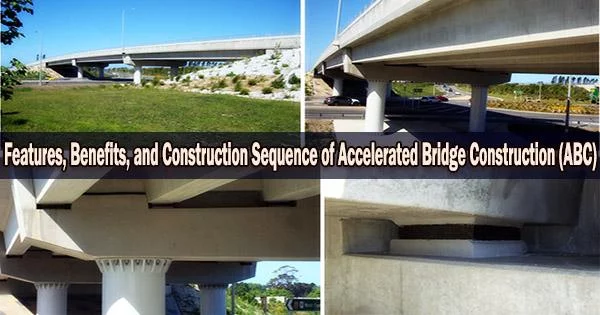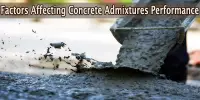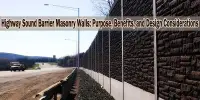Through the application of creative planning, design, resources, and construction methods, Accelerated Bridge Construction (ABC) speeds up bridge construction without sacrificing safety. This approach emphasizes minimizing traffic interruption to the greatest extent possible. This method is used for both new constructions as well as the replacement or rehabilitation of existing bridges.
Without any modifications to the design principles, the same theories have been applied to bridge construction for years. The geometry and configuration of the bridge deck slabs and girders would change as a result of accelerated bridge building design.
Since it is more of an art than a science, accelerated bridge construction is a relatively new field of study. A traditional bridge’s construction differs from an expedited bridge’s construction in that it uses a different construction management system. The research on this area and its aspects are still in progress.
Drawbacks of Conventional Bridge Construction
Until it is finished, bridge building or repair will undoubtedly be a hardship. Large-scale traffic issues, gas waste, and lost labor hours are major issues for the general public and society. These are all bought by conventional bridge construction. Maintenance of bridges to the required standards demands large funds. The highway must be closed for a considerable amount of time for maintenance on bridges experiencing minor flaws and damage.
Hence in the transportation system, the bridge behaves as bottle necks. When compared to bridges built using traditional techniques, those built using the accelerated bridge construction management system have more inventive planning and are more long-lasting.
Need and Promotion of Accelerated Bridge Construction
It is clear that one-fourth of the nation’s bridges need to be completely replaced, repaired, or renovated. Only on-site construction makes this possible, and it has significant negative societal effects on mobility and safety. The direct and indirect costs associated with detours (caused by the loss of bridge transit) have frequently been found to be more than the bridge’s construction costs.
For instance, the industrial and commercial activities of a region are greatly impacted financially by excessive traffic in large urban regions. The economy and safety must therefore be maintained while minimizing traffic interruption. This is of higher priority in accelerated bridge construction. We can altogether summarize as:
- The construction site’s constructability, project length, and work zone safety for passing bybodies are all improved by ABC.
- ABC assists in minimizing the effects of heavy traffic, on-site construction time, and weather-related delays.
Accelerated Bridge Construction composes the following features for its promotion
- Design – Build engineering teams are introduced and the best is selected
- Factories are used to carry out conventional works
- Prefabrication methods are improved
- Use of long vehicles and SPMTs; for transporting components
- Cranes and equipment of high capacity are used
- Co-ordination between the stake holders and the highway agencies for design approval, in a well systematic way
- Construction management is handled by contractors and the consultants. Special contractors and product suppliers are also employed.
- Skilled labor is made available and training are provided if necessary
- Cost-benefit analysis is carried out by planning
- Construction faces modified inspection throughout its course
Distinct Structural and Material Aspects in Accelerated Bridge Construction
Certain features that are employed in accelerated bridge construction make them unique. Some of the main elements are:
- Using light weight material for transporting and erecting. This will help in reducing the overall dead loads.
- Employing Precast abutment walls are a means for quick construction and backfill. This system is not required for conventional construction system.
- Precast Pier Columns is a quick construction remedy, that is not used in conventional construction.
- High-performance concrete and strong steel girders make it possible to create lightweight, extremely durable girder sections. This help in reducing the life cycle costs of the material.
- Prefabricated Deck Panels is a quick construction technique that does not employ expensive formwork. This method is not employed in conventional bridge construction.
- For small and medium spans, precast prestressed girders can be employed.
- Elastomeric bearing pads can be used to provide six degrees of freedom at the girder ends.
- Faster construction is made possible by the simple lowering of partially built bridge components on site. This method is not employed in conventional bridge construction.
- Unlike conventional construction methods, the robotic feature can be used for pouring concrete into multiple joints, nuts, and bolts.
- Use of high early strength grout in joints will let the casted concrete ready for live loads
- High capacity cranes and SPMT lets transportation and erection in ABC, which is not employed in conventional construction.
- Having the right coordination of rapid utilities allows for the swift provision of bridge illumination and signage.
- The prefabricated approach slabs let subgrade preparation, unlike conventional construction.
Classification of span lengths in Accelerated Bridge Construction
As discussed, the ABC method takes less time for construction. This is accomplished by adding variety to the arrangements and building materials. For ABC, these characteristics change depending on the bridge’s various span lengths. In the rapid bridge construction method, the span length determines the type of girder, whether concrete or steel; the erection method also depends on the span length. Such classification is:
- Small Spans: This ought to have a length less than 60 feet. Based on ABC, a timber reinforced concrete, steel, and prestressed concrete girders can be suggested.
- Medium spans: The span length greater than 60 feet and less than 120 feet can be regarded as medium spans. Girders either steel or prestressed can be preferred.
- Long Spans: These have span length ranging from 120 feet to 300 feet. Hybrid girders, steel trusses and high-performance steel (HPS) are the best options, as per ABC.
- Very Long Spans: These have a length from 300 to 600 feet. We make use of segmental construction and cable-stayed bridges based on ABC method.
Categories of Bridge as per Accelerated Bridge Construction
Categories of modern bridges as per ABC theory and span classification. When employing ABC methods, some of them tend to demand special design both in sub and superstructures. Based on the geometry; whether straight, skew or curved decks; the analysis process will vary, hence the final design.
Accelerated Bridge Construction with Multiple Structural Designs
According to every ABC criterion, there are significant differences in the structural layouts. Even the construction of ordinary bridges takes longer since prefabricated parts and elements are used. Hence the ABC construction method can be classified briefly as:
- Partial ABC: Here No formwork is required for the construction
- Fully ABC: Here the elements are prefabricated and are assembled partially in the factory
- Super ABC: Here the whole system components of the structures are fully assembled on site.
Accelerated Bridge Construction Sequence
The flowchart below shows the construction sequence of an accelerated bridge construction.
















